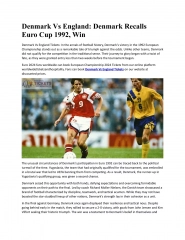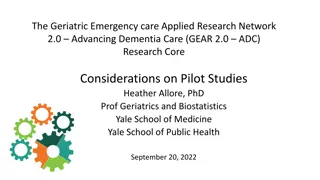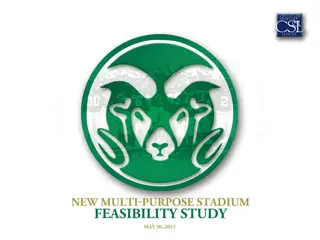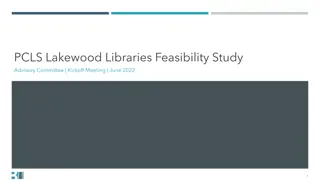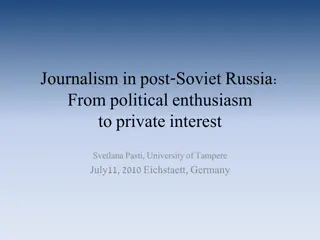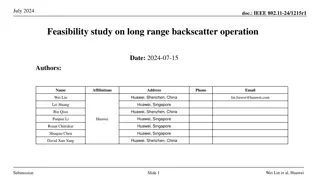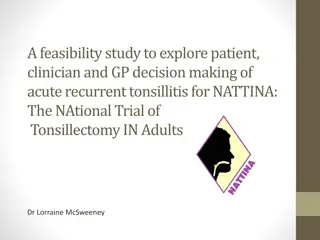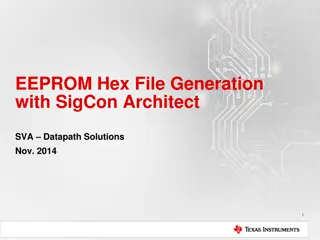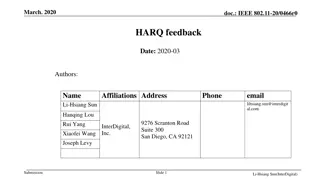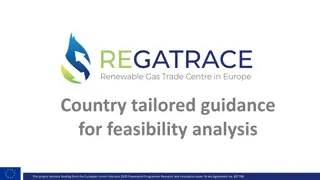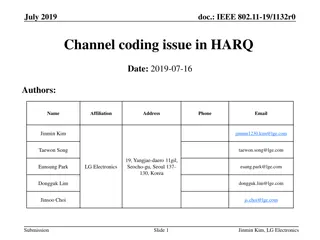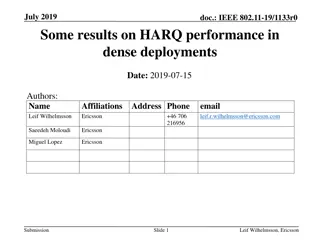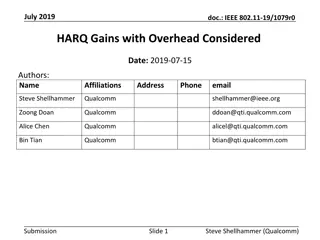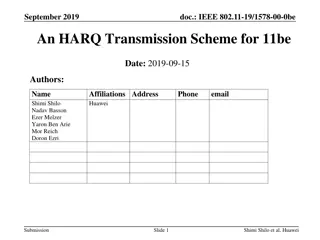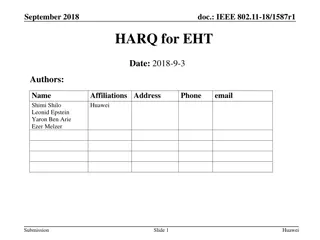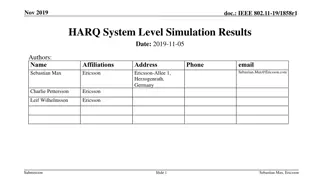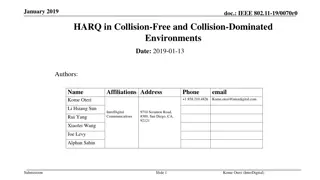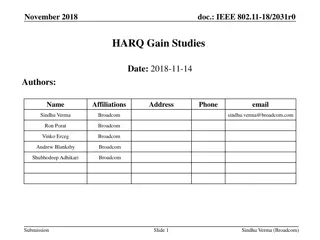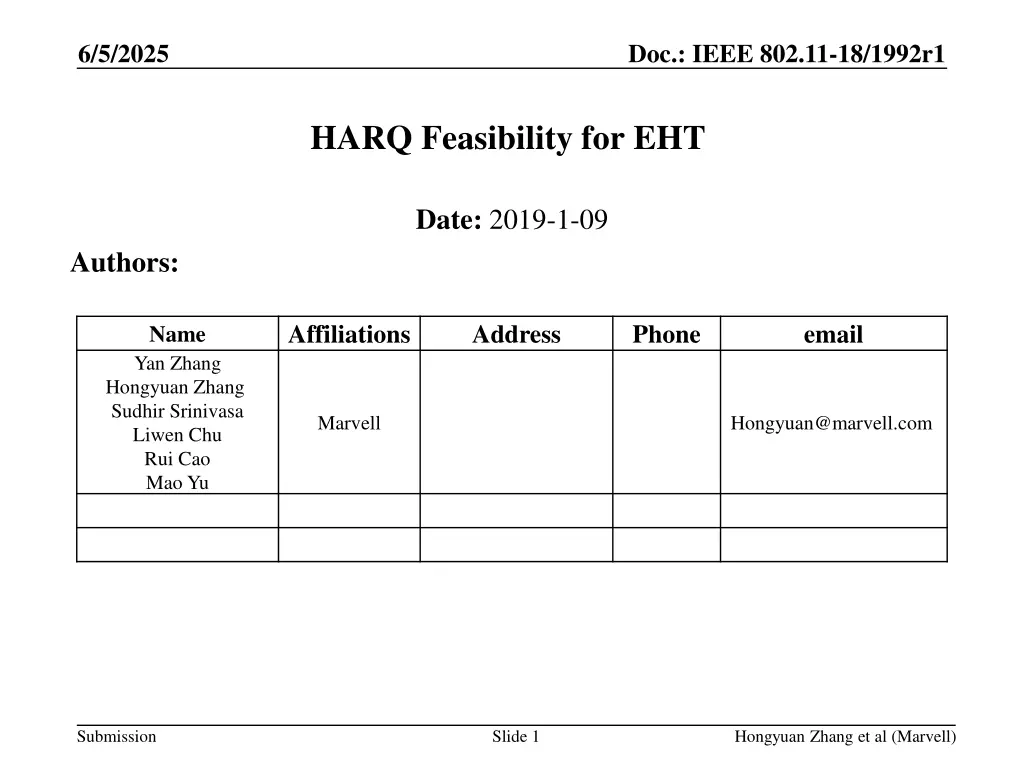
IEEE 802.11-18/1992r1 HARQ Feasibility for Enhanced High Throughput Communications
Explore the feasibility of Hybrid Automatic Repeat reQuest (HARQ) for Enhanced High Throughput (EHT) in the context of IEEE 802.11-18/1992r1 standards. Learn how HARQ enhances link reliability and user experience compared to traditional retransmission schemes. Discover the choices between Chase Combining (CC) and Incremental Redundancy (IR) for HARQ implementations. Simulation setups and results shed light on the benefits of HARQ in improving link stability and mitigating interference effects.
Uploaded on | 2 Views
Download Presentation

Please find below an Image/Link to download the presentation.
The content on the website is provided AS IS for your information and personal use only. It may not be sold, licensed, or shared on other websites without obtaining consent from the author. If you encounter any issues during the download, it is possible that the publisher has removed the file from their server.
You are allowed to download the files provided on this website for personal or commercial use, subject to the condition that they are used lawfully. All files are the property of their respective owners.
The content on the website is provided AS IS for your information and personal use only. It may not be sold, licensed, or shared on other websites without obtaining consent from the author.
E N D
Presentation Transcript
6/5/2025 Doc.: IEEE 802.11-18/1992r1 HARQ Feasibility for EHT Date: 2019-1-09 Authors: Affiliations Address Phone email Name Yan Zhang Hongyuan Zhang Sudhir Srinivasa Liwen Chu Rui Cao Mao Yu Marvell Hongyuan@marvell.com Submission Slide 1 Hongyuan Zhang et al (Marvell)
6/5/2025 Doc.: IEEE 802.11-18/1992r1 HARQ Overview HARQ is claimed as a major feature differentiation of cellular over WLAN. Compared with ARQ (simple retransmission as in current 802.11 MAC), HARQ enables soft combining or additional parity at Rx to improve link level reliability on retransmissions. HARQ may significantly enhance user experience on top of the current 802.11 retransmission schemes. Much higher chance that a retransmission may get through without rate drop. User experience enhancement especially when the connection is weak or experiencing interferences. HARQ may be of less use when link is already strong or stable (e.g. close range, and/or clean environment) Submission Slide 2 Hongyuan Zhang et al (Marvell)
6/5/2025 Doc.: IEEE 802.11-18/1992r1 HARQ Choices HARQ with two flavors: 1. Chase combining (CC)-retry the same coded MPDU. 2. Incremental redundancy (IR) retry with additional parity. HARQ-CC is easier to work with the current 802.11 re- transmission mechanism (at MPDU level). HARQ-IR may require FEC design changes and other major PHY/MAC changes, but could be more efficient than CC. Submission Slide 3 Hongyuan Zhang et al (Marvell)
6/5/2025 Doc.: IEEE 802.11-18/1992r1 Retransmissions Baseline 802.11 retransmission : retry the failed MPDU(s) in the next AMPDU, likely aggregated with fresh MPDUs; when FER is high or when retransmissions keep failing, rate is dropped. How much rate drop may be determined by FER. When combining HARQ with 802.11 AMPDU retransmissions, the chance of rate drop gets much lower due to improved FER see simulation results. This enhances user experience (or link reliability) especially for cases: Long range/weak signal strength OBSS or other interferences come and go . Channel variation, e.g. due to movements (people walking around) Submission Slide 4 Hongyuan Zhang et al (Marvell)
6/5/2025 Doc.: IEEE 802.11-18/1992r1 Simulation setup 20MHz 1x1(1SS) and 2x2 (2SS) DNLOS channel (per channel normalization) 4x HE-LTF, MCS0-11, LDPC HARQ CC Up to 2 or 4 (re)transmissions for each packet, same channel realization is applied across all (re)transmissions for each packet. For the throughput results from slides 7-16, up to 4 (re)transmissions are simulated. Artificial frequency diversity : LPDC mapper patterns are shifted across the (re)transmissions to maximize the frequency domain distance of the same coded bit. DTM are still the same as 11ax Submission Slide 5 Hongyuan Zhang et al (Marvell)
6/5/2025 Doc.: IEEE 802.11-18/1992r1 Simulation setup (Cont) 1000 packets are transmitted via1000 independent channel realizations for PER and throughput evaluations. For PER evaluation, one packet will be sent up to 2 or 4 (re)transmissions until it is correctly decoded. If the packet cannot be decoded correctly after 2 or 4 (re)transmissions, it is counted as an error packet; otherwise it is counted as a successful packet. After sending 1000 packets, PER = total number of error packets/1000. For first transmission PER, the statistics are collected after the first transmission of each packet. For throughput evaluation, Thput = total number of correctly decoded data bits for 1000 packets /total air time used to send 1000 packets. Note that total air time does not include preambles, ACK and SIFs time for simplicity. It only include air time duration for data part. Note that each packet can take up to 4 (re)transmissions. Slide 6 Submission Hongyuan Zhang et al (Marvell)
6/5/2025 Doc.: IEEE 802.11-18/1992r1 HARQ vs ARQ Throughput Comparison (1) ARQ vs HARQ goodput comparision, 20MHz, LDPC, 1x1 140 ARQ optimal MCS selection HARQ CC, optimal MCS selection 120 100 Goodput (Mbps) 80 60 40 20 0 -5 0 5 10 15 20 25 30 35 40 45 SNR (dB) There is up to 2.5dB gain using HARQ CC over ARQ even with optimal link adaptation for the same throughput. Submission Slide 7 Hongyuan Zhang et al (Marvell)
6/5/2025 Doc.: IEEE 802.11-18/1992r1 HARQ vs ARQ Throughput Comparison (2) ARQ vs HARQ goodput comparision, 20MHz, LDPC, 1x1 120 ARQ without rate drop in retx, MCS selection with first Tx PER close to0.1 ARQ with rate drop, MCS selection with first Tx PER close to0.1 HARQ CC, MCS selection with first Tx PER close to0.1 100 80 Goodput (Mbps) 60 40 20 0 5 10 15 20 25 30 35 40 SNR (dB) ARQ without rate drop in retransmission refers to the same MCS is applied across all (re)transmissions. ARQ with rate drop in retransmission refers to MCS is dropped by one level starting from a pre-determined ReTx index (e.g., 3rd Retx) if the previous (re)transmissions are failed. If MCS is selected with first transmission PER around 10%, there is up to 4.5dB gain using HARQ CC over ARQ without rate drop and up to 3.5dB gain over ARQ with rate drop for the same throughput. Submission Slide 8 Hongyuan Zhang et al (Marvell)
6/5/2025 Doc.: IEEE 802.11-18/1992r1 HARQ vs ARQ Throughput Comparison (3) ARQ vs HARQ goodput comparision, 20MHz, LDPC, 1x1 120 ARQ without rate drop in retx, MCS selection with first Tx PER close to0.2 ARQ with rate drop, MCS selection with first Tx PER close to0.2 HARQ CC, MCS selection with first Tx PER close to0.2 100 80 Goodput (Mbps) 60 40 20 0 0 5 10 15 20 25 30 35 40 SNR (dB) If MCS is selected with first transmission PER around 20%, there is up to 8dB gain using HARQ CC over ARQ without rate drop and up to 5.5dB gain over ARQ with rate drop for the same throughput. Submission Slide 9 Hongyuan Zhang et al (Marvell)
6/5/2025 Doc.: IEEE 802.11-18/1992r1 HARQ vs ARQ Throughput Comparison (4) ARQ vs HARQ goodput comparision, 20MHz, LDPC, 1x1 100 ARQ without rate drop in retx, MCS selection with first Tx PER close to0.3 ARQ with rate drop, MCS selection with first Tx PER close to0.3 HARQ CC, MCS selection with first Tx PER close to0.3 90 80 70 Goodput (Mbps) 60 50 40 30 20 10 0 0 5 10 15 20 25 30 35 40 SNR (dB) If MCS is selected with first transmission PER around 30% (this sometimes happens in real scenarios), there is up to 11dB gain using HARQ CC over ARQ without rate drop and up to 8dB gain over ARQ with rate drop for the same throughput. Submission Slide 10 Hongyuan Zhang et al (Marvell)
6/5/2025 Doc.: IEEE 802.11-18/1992r1 HARQ vs ARQ Throughput Comparison (5) ARQ vs HARQ goodput comparision, 20MHz, LDPC, 1x1 90 ARQ without rate drop in retx, MCS selection with first Tx PER close to0.4 ARQ with rate drop, MCS selection with first Tx PER close to0.4 HARQ CC, MCS selection with first Tx PER close to0.4 80 70 60 Goodput (Mbps) 50 40 30 20 10 0 0 5 10 15 20 25 30 35 SNR (dB) If MCS is selected with first transmission PER around 40% (this may happen in real scenarios), there is up to 15dB gain using HARQ CC over ARQ without rate drop and up to 11dB gain over ARQ with rate drop for the same throughput. Submission Slide 11 Hongyuan Zhang et al (Marvell)
6/5/2025 Doc.: IEEE 802.11-18/1992r1 HARQ vs ARQ Throughput Comparison (6) ARQ vs HARQ goodput comparision, 20MHz, LDPC, 2x2, 2SS 180 ARQ optimal MCS selection HARQ CC, optimal MCS selection 160 140 120 Goodput (Mbps) 100 80 60 40 20 0 0 5 10 15 20 SNR (dB) 25 30 35 40 45 There is up to up to 3.5dB gain using HARQ CC over ARQ even with optimal link adaptation for the same throughput. Submission Slide 12 Hongyuan Zhang et al (Marvell)
6/5/2025 Doc.: IEEE 802.11-18/1992r1 HARQ vs ARQ Throughput Comparison (7) ARQ vs HARQ goodput comparision, 20MHz, LDPC, 2x2, 2SS 180 ARQ without rate drop in retx, MCS selection with first Tx PER close to0.1 ARQ with rate drop, MCS selection with first Tx PER close to0.1 HARQ CC, MCS selection with first Tx PER close to0.1 160 140 120 Goodput (Mbps) 100 80 60 40 20 0 10 15 20 25 30 35 40 SNR (dB) If MCS is selected with first transmission PER around 10%, there is up to up to 6dB gain using HARQ CC over ARQ without rate drop and up to 5dB gain over ARQ with rate drop for the same throughput. Submission Slide 13 Hongyuan Zhang et al (Marvell)
6/5/2025 Doc.: IEEE 802.11-18/1992r1 HARQ vs ARQ Throughput Comparison (8) ARQ vs HARQ goodput comparision, 20MHz, LDPC, 2x2, 2SS 150 ARQ without rate drop in retx, MCS selection with first Tx PER close to0.2 ARQ with rate drop, MCS selection with first Tx PER close to0.2 HARQ CC, MCS selection with first Tx PER close to0.2 100 Goodput (Mbps) 50 0 10 15 20 25 30 35 40 SNR (dB) If MCS is selected with first transmission PER around 20%, there is up to up to 9.5dB gain using HARQ CC over ARQ without rate drop and up to 6.5dB gain over ARQ with rate drop for the same throughput. Submission Slide 14 Hongyuan Zhang et al (Marvell)
6/5/2025 Doc.: IEEE 802.11-18/1992r1 HARQ vs ARQ Throughput Comparison (9) ARQ vs HARQ goodput comparision, 20MHz, LDPC, 2x2, 2SS 140 ARQ without rate drop in retx, MCS selection with first Tx PER close to0.3 ARQ with rate drop, MCS selection with first Tx PER close to0.3 HARQ CC, MCS selection with first Tx PER close to0.3 120 100 Goodput (Mbps) 80 60 40 20 0 10 15 20 25 30 35 40 SNR (dB) If MCS is selected with first transmission PER around 30% (this sometimes happen in real scenarios), there is up to up to 11.5dB gain using HARQ CC over ARQ over ARQ without rate drop and up to 9.5dB gain over ARQ with rate drop for the same throughput. Submission Slide 15 Hongyuan Zhang et al (Marvell)
6/5/2025 Doc.: IEEE 802.11-18/1992r1 HARQ vs ARQ Throughput Comparison (10) ARQ vs HARQ goodput comparision, 20MHz, LDPC, 2x2, 2SS 140 ARQ without rate drop in retx, MCS selection with first Tx PER close to0.4 ARQ with rate drop, MCS selection with first Tx PER close to0.4 HARQ CC, MCS selection with first Tx PER close to0.4 120 100 Goodput (Mbps) 80 60 40 20 0 10 15 20 25 30 35 40 SNR (dB) If MCS is selected with first transmission PER around 40% (this may happen in real scenarios), there is up to 14.5dB gain using HARQ CC over ARQ without rate drop and up to 11.3dB gain over ARQ with rate drop for the same throughput. Submission Slide 16 Hongyuan Zhang et al (Marvell)
6/5/2025 Doc.: IEEE 802.11-18/1992r1 PHY Link Level Simulation Results (DNLOS 1x1) Refer to Appendix for all the curves HARQ CC retransmission dB gain over ARQ @ %1 PER for selected cases: Up to 2 (re)transmissions no freq diversity freq diversity Up to 2 (re)transmissions Up to 4 (re)transmissions no freq diversity Up to 4 (re)transmissions freq diversity LDPC, MCS0 1.4dB 4.7dB 3.2dB 7.0dB LDPC, MCS4 2dB 7.8dB 4.0dB 11.5dB LDPC, MCS7 2.1dB 8.8dB 4.6dB 12.7dB LDPC, MCS9 2.1dB 7.9dB 4.0dB 11.7dB Table 1 HARQ CC dB gain over ARQ @1% PER Submission Slide 17 Hongyuan Zhang et al (Marvell)
6/5/2025 Doc.: IEEE 802.11-18/1992r1 Conclusions HARQ may potentially bring big improvement on link reliability, enabling EHT to claim a major differentiation feature from previous gens. Simulations show significant link level (PER) improvement upon ARQ by employing HARQ on the transmissions, especially when LDPC tone mapper patterns are shifted across all (re)transmissions. For the same throughput, HARQ CC provides about 2.5dB gain over ARQ for DNLOS 1x1 channel, and about 3.5dB gain over ARQ for DNLOS 2x2 channel even with optimal MCS selection. HARQ CC provides significant gain over ARQ if MCS selection is not optimal for the current channel state, especially when rate drop is not enabled in the retransmissions, which is common in many rate adaptation algorithms to prevent unnecessary rate drop when packet failure is due to collisions instead of channel degradations. Submission Slide 18 Hongyuan Zhang et al (Marvell)
6/5/2025 Doc.: IEEE 802.11-18/1992r1 Appendix: PER Curves Submission Slide 19 Hongyuan Zhang et al (Marvell)
6/5/2025 Doc.: IEEE 802.11-18/1992r1 LDPC MCS0 (1500bytes) ARQ vs HARQ performance, 20MHz, LDPC, 1x1, MCS0 0 10 ARQ HARQ with freq diversity, up to 2 (re)transmissions HARQ without freq diversity, up to 2 (re)transmissions HARQ with freq diversity, up to 4 (re)transmissions HARQ without freq diversity, up to 4 (re)transmissions -1 10 Per -2 10 -3 10 -2 0 2 4 6 8 10 SNR (dB) Note that up to 4 (re)transmissions are used in ARQ scheme for all PER simulations. There are not much difference for ARQ between up to 2 and up to 4 (re)transmissions. Submission Slide 20 Hongyuan Zhang et al (Marvell)
6/5/2025 Doc.: IEEE 802.11-18/1992r1 LDPC MCS1 (1500 bytes) ARQ vs HARQ performance, 20MHz, LDPC, 1x1, MCS1 0 10 ARQ HARQ with freq diversity, up to 2 (re)transmissions HARQ without freq diversity, up to 2 (re)transmissions HARQ with freq diversity, up to 4 (re)transmissions HARQ without freq diversity, up to 4 (re)transmissions -1 10 Per -2 10 -3 10 0 2 4 6 8 10 12 14 SNR (dB) Submission Slide 21 Hongyuan Zhang et al (Marvell)
6/5/2025 Doc.: IEEE 802.11-18/1992r1 LDPC MCS2 (1500 bytes) ARQ vs HARQ performance, 20MHz, LDPC, 1x1, MCS2 0 10 ARQ HARQ with freq diversity, up to 2 (re)transmissions HARQ without freq diversity, up to 2 (re)transmissions HARQ with freq diversity, up to 4 (re)transmissions HARQ without freq diversity, up to 4 (re)transmissions -1 10 Per -2 10 -3 10 2 4 6 8 10 12 14 16 18 20 SNR (dB) Submission Slide 22 Hongyuan Zhang et al (Marvell)
6/5/2025 Doc.: IEEE 802.11-18/1992r1 LDPC MCS3 (1500 bytes) ARQ vs HARQ performance, 20MHz, LDPC, 1x1, MCS3 0 10 -1 10 Per -2 10 ARQ HARQ with freq diversity, up to 2 (re)transmissions HARQ without freq diversity, up to 2 (re)transmissions HARQ with freq diversity, up to 4 (re)transmissions HARQ without freq diversity, up to 4 (re)transmissions -3 10 4 6 8 10 12 14 16 SNR (dB) Submission Slide 23 Hongyuan Zhang et al (Marvell)
6/5/2025 Doc.: IEEE 802.11-18/1992r1 LDPC MCS4 (1500 bytes) ARQ vs HARQ performance, 20MHz, LDPC, 1x1, MCS4 0 10 ARQ HARQ with freq diversity, up to 2 (re)transmissions HARQ without freq diversity, up to 2 (re)transmissions HARQ with freq diversity, up to 4 (re)transmissions HARQ without freq diversity, up to 4 (re)transmissions -1 10 Per -2 10 -3 10 8 10 12 14 16 18 20 22 24 SNR (dB) Submission Slide 24 Hongyuan Zhang et al (Marvell)
6/5/2025 Doc.: IEEE 802.11-18/1992r1 LDPC MCS5 (1500bytes) ARQ vs HARQ performance, 20MHz, LDPC, 1x1, MCS5 0 10 ARQ HARQ with freq diversity, up to 2 (re)transmissions HARQ without freq diversity, up to 2 (re)transmissions HARQ with freq diversity, up to 4 (re)transmissions HARQ without freq diversity, up to 4 (re)transmissions -1 10 Per -2 10 -3 10 12 14 16 18 20 22 24 26 SNR (dB) Submission Slide 25 Hongyuan Zhang et al (Marvell)
6/5/2025 Doc.: IEEE 802.11-18/1992r1 LDPC MCS6 (1500 bytes) ARQ vs HARQ performance, 20MHz, LDPC, 1x1, MCS6 0 10 ARQ HARQ with freq diversity, up to 2 (re)transmissions HARQ without freq diversity, up to 2 (re)transmissions HARQ with freq diversity, up to 4 (re)transmissions HARQ without freq diversity, up to 4 (re)transmissions -1 10 Per -2 10 -3 10 12 14 16 18 20 22 24 26 28 30 SNR (dB) Submission Slide 26 Hongyuan Zhang et al (Marvell)
6/5/2025 Doc.: IEEE 802.11-18/1992r1 LDPC MCS7 (1500bytes) ARQ vs HARQ performance, 20MHz, LDPC, 1x1, MCS7 0 10 ARQ HARQ with freq diversity, up to 2 (re)transmissions HARQ without freq diversity, up to 2 (re)transmissions HARQ with freq diversity, up to 4 (re)transmissions HARQ without freq diversity, up to 4 (re)transmissions -1 10 Per -2 10 -3 10 14 16 18 20 22 24 26 28 30 32 34 SNR (dB) Submission Slide 27 Hongyuan Zhang et al (Marvell)
6/5/2025 Doc.: IEEE 802.11-18/1992r1 LDPC MCS8 (1500 bytes) ARQ vs HARQ performance, 20MHz, LDPC, 1x1, MCS8 0 10 ARQ HARQ with freq diversity, up to 2 (re)transmissions HARQ without freq diversity, up to 2 (re)transmissions HARQ with freq diversity, up to 4 (re)transmissions HARQ without freq diversity, up to 4 (re)transmissions -1 10 Per -2 10 -3 10 18 20 22 24 26 28 30 32 34 SNR (dB) Submission Slide 28 Hongyuan Zhang et al (Marvell)
6/5/2025 Doc.: IEEE 802.11-18/1992r1 LDPC MCS9 (1500 bytes) ARQ vs HARQ performance, 20MHz, LDPC, 1x1, MCS9 0 10 ARQ HARQ with freq diversity, up to 2 (re)transmissions HARQ without freq diversity, up to 2 (re)transmissions HARQ with freq diversity, up to 4 (re)transmissions HARQ without freq diversity, up to 4 (re)transmissions -1 10 Per -2 10 -3 10 20 22 24 26 28 30 32 34 36 38 SNR (dB) Submission Slide 29 Hongyuan Zhang et al (Marvell)
6/5/2025 Doc.: IEEE 802.11-18/1992r1 LDPC MCS10 (1500 bytes) ARQ vs HARQ performance, 20MHz, LDPC, 1x1, MCS10 0 10 ARQ HARQ with freq diversity, up to 2 (re)transmissions HARQ without freq diversity, up to 2 (re)transmissions HARQ with freq diversity, up to 4 (re)transmissions HARQ without freq diversity, up to 4 (re)transmissions -1 10 Per -2 10 -3 10 24 26 28 30 32 34 36 38 40 SNR (dB) Submission Slide 30 Hongyuan Zhang et al (Marvell)
6/5/2025 Doc.: IEEE 802.11-18/1992r1 LDPC MCS11 (1500 bytes) ARQ vs HARQ performance, 20MHz, LDPC, 1x1, MCS11 0 10 ARQ HARQ with freq diversity, up to 2 (re)transmissions HARQ without freq diversity, up to 2 (re)transmissions HARQ with freq diversity, up to 4 (re)transmissions HARQ without freq diversity, up to 4 (re)transmissions -1 10 Per -2 10 -3 10 26 28 30 32 34 36 38 40 42 44 SNR (dB) Submission Slide 31 Hongyuan Zhang et al (Marvell)

